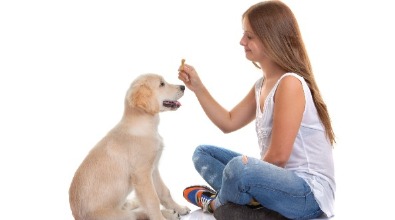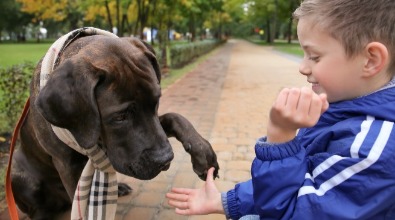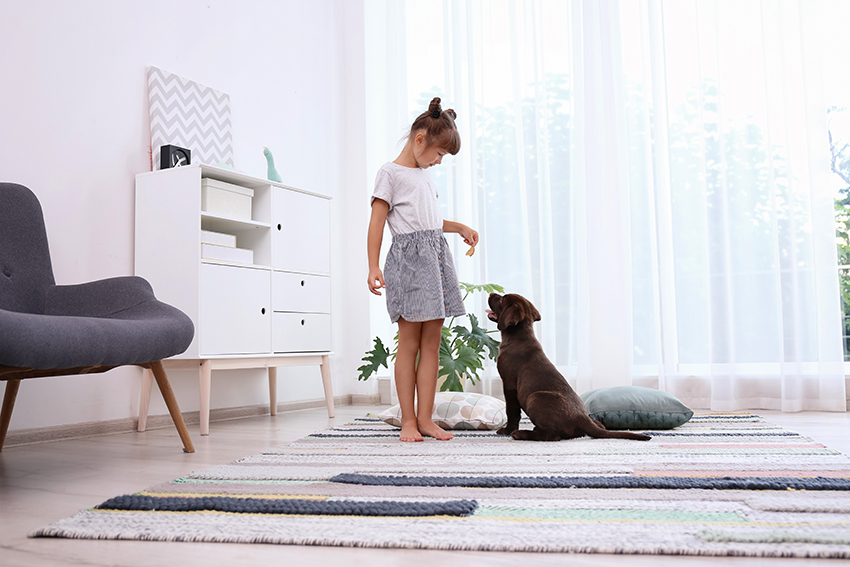In this post:
- Why should your children train the family dog
- Teach your child to give a dog a treat
For many children, getting a family dog is one of the happiest experiences imaginable. They are excited and are usually very eager to be involved in everything from training to feeding to walks. However, their enthusiasm for the new pup can derail training and can even teach your dog some unwanted behaviors.
Why should your children train the family dog?
The number one reason is that it can keep your children safe.
Texas Veterinary Medical Association (TVMA) states that there are an estimated 4.5 million dog bites are reported each year, according to the Centers for Disease Control and Prevention, and 20 percent of these incidents require emergency medical care. At least half of the victims who require medical attention are children.
According to Pat Miller, CBCC-KA, CPDT-KA, “Your best insurance against your family being part of these statistics is a puppy-raising program that incorporates proper management and supervision and tons of carefully orchestrated, positive social experiences for your new dog.”
Training offers this nourishing environment for both your child and your dog! It is a place where both can bond and form a stronger relationship. Your dog will learn to respect your child and will know how to act around children (socialization). And your child will learn how to best interact with the family dog and be able to channel their energy and enthusiasm into a safe activity.

Training methods matter!
It is critical to use positive reinforcement training! Training that includes any fear or pain can teach your dog to associate your child with unpleasant things. Leading for them to develop fear or aggression toward the child. Training that focuses on using treats and rewards will teach your dog that children mean good things will happen. Your dog will be excited and happy to be around children.
According to Pat Miller, CBCC-KA, CPDT-KA, “when they learn positive training techniques, kids learn how to interact with and influence the behavior of other sentient beings without using force, fear, pain, or intimidation. These are skills that may serve them well in their interactions with their friends, classmates, and perhaps even their siblings!”
And we cannot stress this enough: Never leave your child unattended with your dog!
I encourage the parents to just supervise, but really let the kids take the reigns. You should be there just to guide your child and make sure no accidents happen.

Teach your child to give a dog a treat
Because treats can be exciting for your dog, it is important to teach your child the steps above to help keep your dog from biting while taking the treat. Remember that some dogs generalize better than others, so if your dog takes treats appropriately from you doesn’t automatically mean they will do so from your child. Always supervise dog-child interactions.
- Have the treat in the fist so the dog can’t get it and can’t accidentally bite a finger.
- Ask the dog to do something – it can be some basic command like sit, down, or stay.
- Then give the treat when the dog performs the command.
- Have an open hand so the dog licks it off the palm rather than tries to bite it out of your fingers. Or you can instruct the child to throw the treat on the ground to prevent the dog from biting their fingers.
- Don’t give a dog a treat that is biting at you or is super excited.
Final thoughts:
You need to take special precautions when bringing a new dog into a home with children. It’s a great idea to involve your children in training your new four-legged family member, but be sure that all parties are safe so that there is no possibility of a bad or harmful situation. Using the tips above you can ensure a great opportunity for your child to form a bond with your new dog and that is the best way to maintain peace and harmony within your home.





